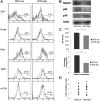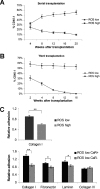A low level of reactive oxygen species selects for primitive hematopoietic stem cells that may reside in the low-oxygenic niche
- PMID: 17595331
- PMCID: PMC2018677
- DOI: 10.1182/blood-2007-05-087759
A low level of reactive oxygen species selects for primitive hematopoietic stem cells that may reside in the low-oxygenic niche
Abstract
A low-oxygenic niche in bone marrow limits reactive oxygen species (ROS) production, thus providing long-term protection for hematopoietic stem cells (HSCs) from ROS stress. Although many approaches have been used to enrich HSCs, none has been designed to isolate primitive HSCs located within the low-oxygenic niche due to difficulties of direct physical access. Here we show that an early HSC population that might reside in the niche can be functionally isolated by taking advantage of the relative intracellular ROS activity. Many attributes of primitive HSCs in the low-oxygenic osteoblastic niche, such as quiescence, and calcium receptor, N-cadherin, Notch1, and p21 are higher in the ROS(low) population. Intriguingly, the ROS(low) population has a higher self-renewal potential. In contrast, significant HSC exhaustion in the ROS(high) population was observed following serial transplantation, and expression of activated p38 mitogen-activated protein kinase (MAPK) and mammalian target of rapamycin (mTOR) was higher in this population. Importantly, treatment with an antioxidant, a p38 inhibitor, or rapamycin was able to restore HSC function in the ROS(high) population. Thus, more potent HSCs associated with the low-oxygenic niche can be isolated by selecting for the low level of ROS expression. The ROS-related signaling pathways together with specific characteristics of niche HSCs may serve as targets for beneficial therapies.
Figures





Similar articles
-
Reactive oxygen species act through p38 MAPK to limit the lifespan of hematopoietic stem cells.Nat Med. 2006 Apr;12(4):446-51. doi: 10.1038/nm1388. Epub 2006 Mar 26. Nat Med. 2006. PMID: 16565722
-
TSC-mTOR maintains quiescence and function of hematopoietic stem cells by repressing mitochondrial biogenesis and reactive oxygen species.J Exp Med. 2008 Sep 29;205(10):2397-408. doi: 10.1084/jem.20081297. Epub 2008 Sep 22. J Exp Med. 2008. PMID: 18809716 Free PMC article.
-
Function of oxidative stress in the regulation of hematopoietic stem cell-niche interaction.Biochem Biophys Res Commun. 2007 Nov 23;363(3):578-83. doi: 10.1016/j.bbrc.2007.09.014. Epub 2007 Sep 18. Biochem Biophys Res Commun. 2007. PMID: 17897629
-
Maintenance of quiescent hematopoietic stem cells in the osteoblastic niche.Ann N Y Acad Sci. 2007 Jun;1106:41-53. doi: 10.1196/annals.1392.005. Epub 2007 Mar 1. Ann N Y Acad Sci. 2007. PMID: 17332071 Review.
-
Reactive oxygen species regulate hematopoietic stem cell self-renewal, migration and development, as well as their bone marrow microenvironment.Antioxid Redox Signal. 2014 Oct 10;21(11):1605-19. doi: 10.1089/ars.2014.5941. Epub 2014 Jun 26. Antioxid Redox Signal. 2014. PMID: 24762207 Free PMC article. Review.
Cited by
-
CD271+ Mesenchymal Stem Cells as a Possible Infectious Niche for Leishmania infantum.PLoS One. 2016 Sep 13;11(9):e0162927. doi: 10.1371/journal.pone.0162927. eCollection 2016. PLoS One. 2016. PMID: 27622907 Free PMC article.
-
Mechanosignaling in the vasculature: emerging concepts in sensing, transduction and physiological responses.Am J Physiol Heart Circ Physiol. 2015 Jun 15;308(12):H1451-62. doi: 10.1152/ajpheart.00105.2015. Epub 2015 Apr 10. Am J Physiol Heart Circ Physiol. 2015. PMID: 25862828 Free PMC article. Review.
-
Lysosomes and Their Role in Regulating the Metabolism of Hematopoietic Stem Cells.Biology (Basel). 2022 Sep 27;11(10):1410. doi: 10.3390/biology11101410. Biology (Basel). 2022. PMID: 36290314 Free PMC article. Review.
-
Normal Hematopoietic Progenitor Subsets Have Distinct Reactive Oxygen Species, BCL2 and Cell-Cycle Profiles That Are Decoupled from Maturation in Acute Myeloid Leukemia.PLoS One. 2016 Sep 26;11(9):e0163291. doi: 10.1371/journal.pone.0163291. eCollection 2016. PLoS One. 2016. PMID: 27669008 Free PMC article.
-
Targeted knock-in of NCF1 cDNA into the NCF2 locus leads to myeloid phenotypic correction of p47 phox -deficient chronic granulomatous disease.Mol Ther Nucleic Acids. 2024 May 24;35(3):102229. doi: 10.1016/j.omtn.2024.102229. eCollection 2024 Sep 10. Mol Ther Nucleic Acids. 2024. PMID: 38952440 Free PMC article.
References
-
- Saretzki G, Armstrong L, Leake A, Lako M, von Zglinicki T. Stress defense in murine embryonic stem cells is superior to that of various differentiated murine cells. Stem Cells. 2004;22:962–971. - PubMed
-
- Csete M, Walikonis J, Slawny N, et al. Oxygen-mediated regulation of skeletal muscle satellite cell proliferation and adipogenesis in culture. J Cell Physiol. 2001;189:189–196. - PubMed
-
- Suda T, Arai F, Hirao A. Hematopoietic stem cells and their niche. Trends Immunol. 2005;26:426–433. - PubMed
-
- Piccoli C, Ria R, Scrima R, et al. Characterization of mitochondrial and extra-mitochondrial oxygen consuming reactions in human hematopoietic stem cells. J Biol Chem. 2005;280:26467–26476. - PubMed
Publication types
MeSH terms
Substances
Grants and funding
LinkOut - more resources
Full Text Sources
Other Literature Sources
Medical
Research Materials
Miscellaneous

